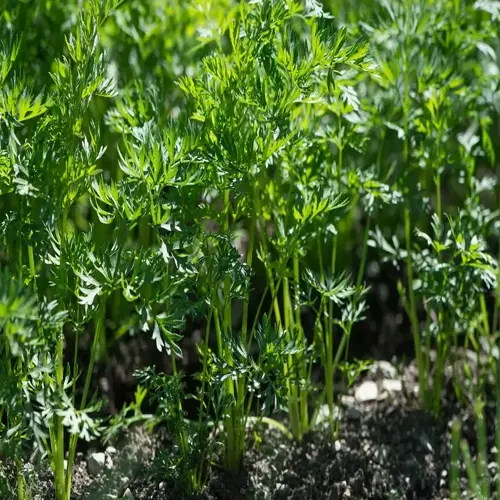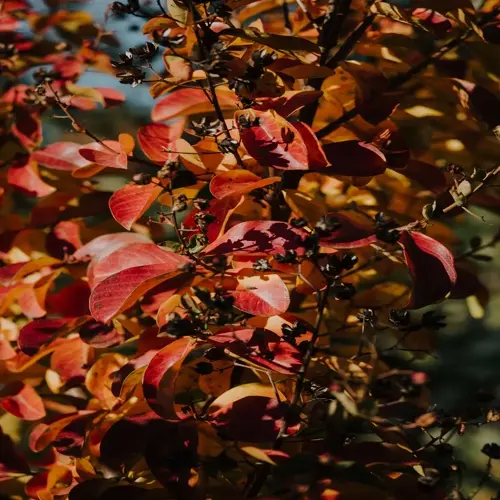When to Plant Perennials: Expert Guide

Written by
Michael Sullivan
Reviewed by
Prof. Samuel Fitzgerald, Ph.D.Perennials are best planted in spring or fall.
Spring planting needs soil temperature between 50 - 65°F for roots to develop.
Fall planting makes use of soil that is still warm for your plants to establish roots before dormancy in winter.
Do not plant during the summer when the temperature is above 85°F since failure rates are too high.
You can adjust your planting timetable according to USDA zones.
With the right planting depth and space, you can prevent overcrowding and disease.
Article Navigation
Knowing when to plant perennials is extremely important because they live for three or more years. The future health of the perennial plant is solely based on proper timing. I've seen gardens thrive, or die, based on that one decision. The consequences, limited root establishment, could be undesirable for planting out of season.
Planting in the spring takes advantage of the warming soil, which promotes growth. Planting in the fall allows the plant to establish its roots in the residual summer warmth. Each season has its benefits and disadvantages for perennials, and making the correct choice can lead to more established plants. Your garden's eventual success begins with this important decision about timing.
The success of blooming is directly related to the timing of planting. Get it right, and you'll enjoy years of color. Once, I helped a client save their astilbes by planting them sooner. Everything is affected by timing, from insect pressure to winter survivorship.
Common Planting Mistakes
Crowded plants are one of the biggest mistakes I notice in new gardens. When plants are crowded, too much plant material retains moisture, leading to mildew attacks. I find this result invariably produces only 50% of the total number of blooms. Always be mindful of the mature size. Use the measurements on the plants' tags or measure the width with a tape measure at the time of hole digging.
Errors in planting depth will create immediate stress. Planting crowns underground can cause decay, and planting roots too shallow will result in dryness. Zone 5 gardeners lose lavender this way. One inch of crown above soil level is a key to success. This easy step provides additional protection from most fungal problems.
Miscalculating seasonal timing can lead to catastrophic outcomes. If you planted heat-sensitive astilbes in a hot June sun zone 7- 9, those astilbes will perish. Always verify the temperature requirements. I highly recommend using soil thermometers for the best accuracy. This tool has saved innumerable plants from my designs.
Planting in frozen soil during the fall can disrupt the root system. Our northern gardeners know this in late October. Instead of growing in frozen ground, wait for the spring thaw. By waiting, you will benefit from rapid growth. Timing is crucial for a healthy plant that will require less maintenance in the future.
Perennial Selection Guide
Begin your perennial groupings according to sun exposure needs. For example, when growing full sun lovers like Coneflower, they require six hours of direct mericlinal light. In contrast, shade specialists like hostas will fry in the afternoon sun. I often draw garden beds with sun maps to prevent planting calamities.
When plants bloom determines how long they will provide interest in your landscape. Some early-season bloomers, like bleeding hearts, will be done blooming around summer. At the same time, some late-season bloomers, such as asters, will extend the show into autumn. We created a succession of blooms for continuous color. My clients' gardens maintain color up to ten months a year with this simple calendar approach.
Companion planting creates a natural balance in your garden. Lavender protects nearby roses from unwanted bugs. Ferns protect hellebore roots from sun damage. My go-to is Russian sage mixed with ornamental grasses for texture. These combinations reduce gardening work while increasing beauty.
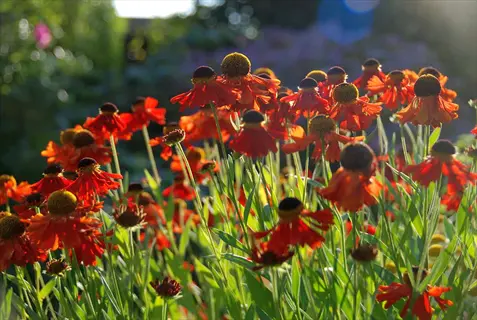
Coneflowers
- Coneflowers thrive in full sun conditions, requiring at least six hours of direct daily sunlight to develop their vibrant purple, pink, or white blooms throughout summer
- Once established, these drought-tolerant perennials need minimal watering, making them excellent choices for water-wise gardens in various climate zones
- From midsummer through early fall, coneflower blooms attract numerous butterflies and bees, providing essential late-season nectar sources for pollinators
- Growing two to four feet tall, they work well when paired with black-eyed Susans or ornamental grasses that complement their texture and form
- To maintain vigorous growth, divide coneflower clumps every three years in early spring before new growth emerges
- These hardy plants tolerate poor soil conditions but perform best in well-draining locations with moderate fertility
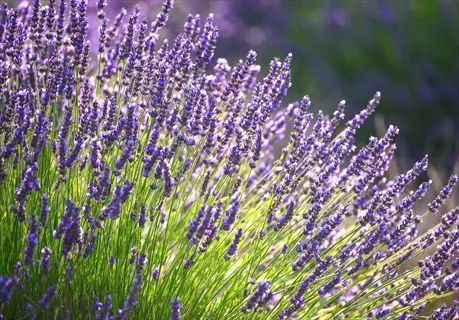
Lavender
- Lavender demands full sun exposure and exceptionally well-draining soil to prevent root rot problems that can occur in heavy or moist conditions
- Blooming from late spring through summer, its fragrant purple flowers attract pollinators while naturally repelling deer and rabbits from garden areas
- Once established, these drought-resistant plants require deep but infrequent watering, making them ideal for xeriscaping and low-water landscapes
- Prune lavender back by approximately one-third in early spring to encourage bushy growth and prevent woody, leggy development
- Ideal for borders, containers, or as aromatic ground cover, lavender adds both visual appeal and fragrance to garden designs
- Harvest flower spikes just as buds begin to open for optimal fragrance retention in dried arrangements and sachets
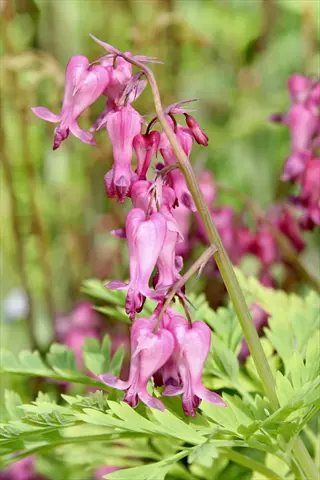
Bleeding Hearts
- Bleeding hearts prefer partial to full shade locations with consistently moist, humus-rich soil that mimics their native woodland growing environments
- In spring, they produce distinctive heart-shaped pink or white flowers on arching stems that reach one to three feet tall
- Combine with hostas and ferns to create beautifully layered shade gardens with contrasting foliage textures and forms
- These plants naturally go dormant in summer heat, so mark their locations carefully to avoid accidental disturbance during this period
- Divide bleeding hearts every four to five years in early fall or spring to maintain plant vigor and flowering performance
- Provide protection from harsh afternoon sun which can scorch their delicate foliage and shorten the blooming period
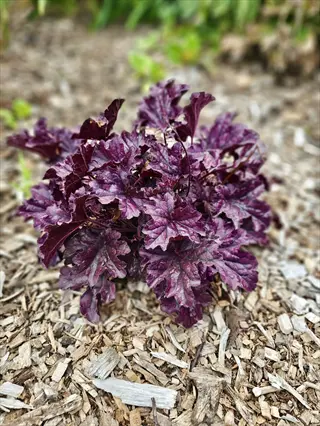
Coral Bells
- Coral bells tolerate various light conditions from sun to partial shade depending on cultivar, though most prefer afternoon shade in hot climates
- Prized for their colorful foliage ranging from deep purple to vibrant lime green, they provide season-long interest even when not blooming
- Delicate flower spikes appear in late spring to early summer, attracting hummingbirds with their nectar-rich blossoms above the foliage
- Growing one to two feet tall with a mounding habit, they make excellent container plants or border edging specimens
- They require consistent moisture but need well-draining soil to prevent crown rot, especially during winter dormancy periods
- Divide plants every three years to maintain compact growth and vibrant leaf coloration that can fade in older plants
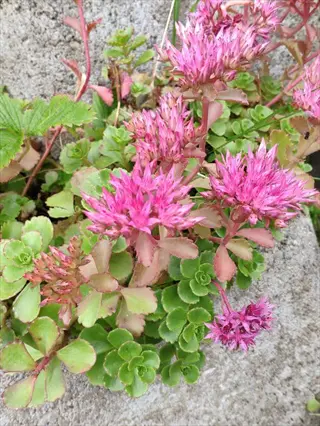
Sedum
- Sedum thrives in full sun locations with extremely well-draining sandy or gravelly soil conditions that prevent moisture retention around roots
- These plants exhibit exceptional drought tolerance once established, requiring minimal supplemental watering even during extended dry periods
- Blooming in late summer to fall with star-shaped flower clusters, they provide critical late-season nectar for migrating butterflies
- Varieties range from low-growing ground covers to upright types reaching three feet tall, suitable for various garden applications
- As butterfly magnets, they're essential in pollinator gardens, offering nectar when few other flowers are available in autumn
- Require minimal care but avoid overwatering and rich soils which cause floppy growth and reduce their natural drought resistance
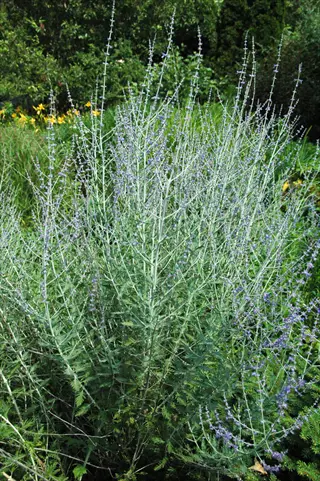
Russian Sage
- Russian sage needs full sun exposure and excellent drainage to thrive, making it perfect for hot, dry garden locations with poor soil
- This drought-resistant perennial features aromatic silvery foliage and abundant purple blooms that persist from midsummer through fall
- Growing three to five feet tall with airy flower spikes, it adds valuable vertical dimension and movement to garden borders
- Its extended blooming period consistently attracts bees and other pollinators when many other flowers have finished flowering
- Prune back hard in early spring before new growth starts to maintain compact form and encourage abundant flowering
- Combine with ornamental grasses like switchgrass or feather reed grass to create attractive textural contrasts in landscape designs
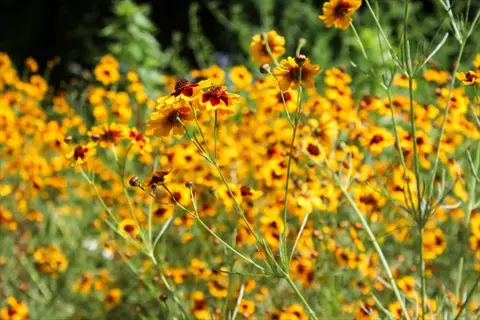
Blanket Flower
- Blanket flowers require full sun exposure and readily tolerate poor, dry soils where other perennials might struggle to establish properly
- Once established, these drought-tolerant plants need minimal watering, making them excellent choices for low-maintenance and xeric gardens
- They produce abundant daisy-like red and yellow blooms throughout summer, providing continuous color in challenging growing conditions
- Growing one to three feet tall depending on variety, they work well in mass plantings or as colorful border accents
- Regular deadheading encourages continuous flowering cycles and prevents excessive self-seeding that can occur in ideal conditions
- These flowers attract butterflies while naturally resisting deer browsing due to their slightly fuzzy foliage texture
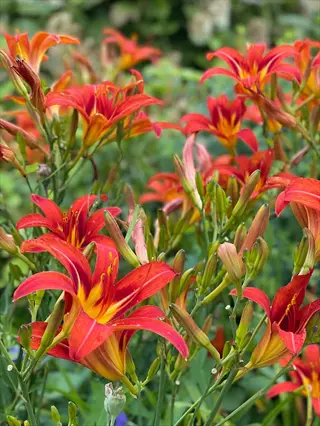
Daylilies
- Daylilies adapt well to various light conditions from full sun to partial shade, though flowering is best with at least six hours of sun
- They tolerate various soil types except constantly wet locations where crown rot can develop and damage the plant over time
- Blooming in summer, each trumpet-shaped flower lasts just one day but plants produce numerous buds for extended blooming periods
- Varieties range from one to four feet in mature height, offering options for front, middle, or back positions in borders
- Divide clumps every three to four years in early spring or fall to maintain flowering vigor and prevent overcrowding issues
- With hundreds of color options and low-maintenance requirements, they're excellent choices for beginner gardeners and landscapes
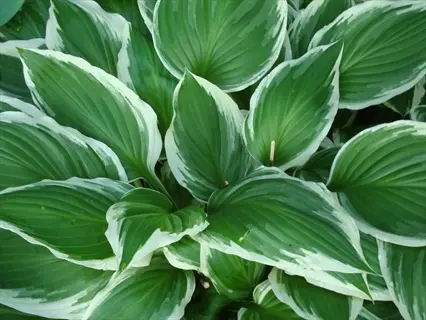
Hostas
- Hostas prefer partial to full shade locations with protection from hot afternoon sun which can scorch their delicate foliage
- They thrive in consistently moist, well-draining soil enriched with organic matter to support their lush leafy growth habit
- Grown primarily for their attractive foliage ranging from blue-green to gold, they provide texture in shade gardens all season
- Sizes vary dramatically from six-inch miniatures perfect for rock gardens to four-foot giants that serve as focal points
- Flowering in midsummer with lavender or white spikes, some varieties feature fragrant blooms that add nighttime interest
- In damp garden environments, implement slug control measures since these pests can severely damage hosta foliage overnight
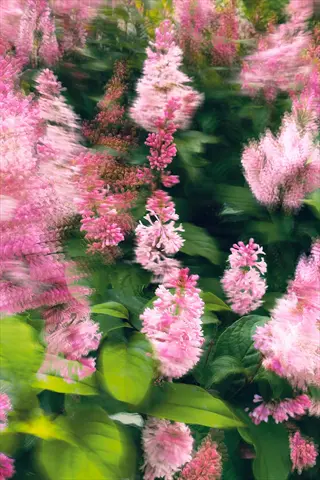
Astilbe
- Astilbe needs partial to full shade and consistently moist soil conditions to thrive, making them ideal for damp shade gardens
- They bloom in early to midsummer with feathery plumed flowers in shades of pink, red, purple, or white above fern-like foliage
- Reaching one to four feet tall depending on cultivar, they add vertical interest and soft texture to shaded garden areas
- Combine with ferns to create lush, textured shade garden combinations that provide continuous interest throughout the season
- Divide plants every four years in early spring to maintain vigorous flowering and prevent center die-out in mature clumps
- Apply mulch annually to help retain soil moisture and keep roots cool during summer heat spells in warmer growing zones
Watering and Aftercare
First-year perennials require meticulous watering. Water thoroughly twice a week for a month to encourage root development. Established plants can thrive on weekly servings, except during hot weather. I lost some young lavender during a drought before discovering this significant difference. Their root systems are just not ready to handle stress.
Apply mulch correctly. Two to three inches, or five to seven centimeters, around the plants is just right. Keep it two inches away from stems. This causes rot and moisture retention. The survival rate of my garden improved dramatically after implementing these metrics.
I modify watering with temp alterations. Increase watering if the temperature is above 85°F or 29°C. Decrease if below 50°F or 10°C. I monitor soil temperature using a probe. This prevents root shock with extreme weather. Your plants will definitely show gratitude with fast growth.
Frost protection measures regarding first freeze dates. Winter insulation of crowns after a cold, hard frost. I use straw blankets in my zone five garden. Applying mulch too early could cause damage from rodents. The right timing saves plants every winter.
First-Year Watering Schedule
- Water deeply twice weekly for the first month after planting to encourage deep root development in the initial establishment phase
- Reduce to once weekly during moderate temperatures (60-80°F/16-27°C) unless rainfall exceeds one inch (2.5 cm) within seven days
- Increase frequency to every three days during heatwaves above 85°F (29°C) to prevent drought stress in vulnerable new plants
Mulching Techniques
- Apply 2-3 inches (5-7.5 cm) of organic mulch like shredded bark or compost around plants, keeping it 2 inches (5 cm) from stems to prevent rot
- Replenish mulch annually in early spring to maintain moisture retention and suppress weeds as the material decomposes over time
- Use lightweight mulch like straw for winter protection in zones below 5, removing excess in spring to allow soil warming
Seasonal Adjustments
- Increase watering during summer droughts when temperatures exceed 85°F (29°C), providing one inch (2.5 cm) of water weekly via slow soaking methods
- Reduce watering in fall as temperatures drop below 50°F (10°C), allowing plants to harden off before winter dormancy periods begin
- Suspend watering during winter except for evergreen perennials in snow-free regions where monthly deep watering prevents desiccation damage
Winter Protection
- Insulate plant crowns with 4-6 inches (10-15 cm) of straw after first hard freeze in zones 3-5 to prevent frost heave damage
- Wrap sensitive perennials like rosemary in burlap when temperatures drop below 20°F (-7°C), removing protection once frost danger passes
- Avoid pruning after late summer to prevent tender new growth that cannot withstand freezing temperatures below 32°F (0°C)
Long-Term Maintenance
- Fertilize sparingly in early spring using balanced 10-10-10 formula at half strength to avoid excessive foliage over blooms
- Divide overcrowded perennials every 3-5 years in early spring or fall, ensuring each division has healthy roots and shoots
- Monitor for pests like aphids during new growth phases, using insecticidal soap sprays only when infestations exceed five insects per stem
Step-by-Step Planting Guide
First, begin "site preparation" by mulching a three-foot (or ninety-centimeter) circle, removing all weeds. Amend the soil with two to three inches (5 to 7 centimeters) of compost, and perform a pH test, as most perennials prefer a pH range of 6.0 to 7.0. I test before planting season every time.
Dig holes twice as wide as the root ball but the same depth as the pot. For bareroot plants, create a soil cone in the center. Use gravel for clay soils or water crystals for sandy areas. Spring planting requires wider holes than fall.
Be mindful of the roots! Carefully tease the root-bound roots outwards, place crowns one inch or two centimeters above the soil level, except for iris rhizomes. With bare root, spread the roots over the cones without bending. I have saved many plants at this step by avoiding root damage.
Backfill halfway and then water to settle the soil around the plant. Finish filling and build a two-inch, or five-centimeter soil rim. Lightly tamp down to remove any air pockets. Fall plantings will require more frequent and deeper watering than spring plantings. This will help prevent runoff moisture during fall rains.
Water thoroughly until the soil depth reaches eight inches (or twenty centimeters). Add some soil if the settling exposes roots. Water every three days for spring plantings. Water weekly for fall, provided there are no rains beforehand. For taller varieties, stake them immediately to avoid disturbing the roots later.
Site Preparation
- Clear all weeds and debris from a 3-foot (90 cm) diameter area, removing perennial weed roots completely to prevent regrowth
- Amend soil with 2-3 inches (5-7.5 cm) of compost, mixing thoroughly to improve drainage and nutrient content
- Conduct soil pH test; most perennials prefer 6.0-7.0. Add lime to raise pH or sulfur to lower if needed
Digging the Hole
- Dig hole 2x wider than root ball but same depth as nursery pot (e.g., 12-inch/30 cm wide hole for 6-inch/15 cm pot)
- For bareroot plants: Create cone-shaped mound in center to spread roots over
- In clay soils: Add 1 inch (2.5 cm) gravel layer for drainage; in sandy soils, add water-retention crystals
Plant Positioning
- Remove plant from container; tease encircled roots gently to stimulate outward growth
- Set crown 1 inch (2.5 cm) above soil line for drainage (except iris: rhizomes at surface)
- For bareroot: Position crown at soil line, spread roots over mound without bending
Backfilling
- Backfill halfway with native soil-compost mix; water thoroughly to settle soil
- Complete backfill; create watering well by mounding 2-inch (5 cm) soil rim around perimeter
- Firm soil gently with hands, avoid compaction, to eliminate air pockets while maintaining structure
Initial Watering
- Water slowly until soil is saturated to 8-inch (20 cm) depth, approximately 1 gallon (3.8 L) per plant
- Add soil if settling occurs; maintain crown exposure
- Spring planting: Water every 3 days first month; Fall: Water weekly unless rainy
Post-Planting Care
- Apply 2-3 inches (5-7.5 cm) mulch, keeping clear from stem
- Install support stakes for tall varieties immediately to avoid root disturbance later
- Monitor daily first week for wilting; provide temporary shade if temperatures exceed 80°F (27°C)
Optimal Planting Seasons
Spring planting is most effective between 50-65°F (10-18°C), as this warming initiates root growth without heat stress. Late-blooming flowers, daylilies, and phlox are great to plant in this window. They'll get established and ready for summer blooms. I usually approach spring planting with more heat-tolerant varieties.
Fall planting utilizes air temperatures 45-60°F or 7-15°C. Even if the air temperature is 45°, the soil retains the summer heat, and roots can establish themselves in any area with not too cold below-ground heat for rooting. Early bloomers, such as peonies and irises, require winter chill; they will not perform optimally without it in the spring. My clients can utilize fall planting, which offers a 30% benefit in terms of improved growth.
For timing based on USDA zone, begin planting when the soil temperature at a four-inch or ten-centimeter depth is between Zone 3 and Zone 4, which is typically from May to late August. Zone 7-8 = March or October. I measure soil temperature using a thermometer, so it is not a guess. This will prevent seasonal timing errors.
Allow 6 weeks for root establishment before extremes in temperature, e.g., more growth in spring with longer days of soft spring sunshine, as opposed to fall plants, which grow roots until the ground freezes. Both will create solid foundations. If established correctly, your perennials will reward you with years of colorful flowers.
Spring Planting Advantages
- Warming soil temperatures between 50-65°F (10-18°C) stimulate rapid root growth without heat stress
- Reliable spring rainfall patterns reduce watering needs during critical establishment phase
- Longer daylight hours accelerate photosynthesis and foliage development
- Ideal for late-summer bloomers: Daylilies, Salvias, Phlox, Rudbeckia, and Coreopsis
Fall Planting Advantages
- Warm soil retained from summer supports root growth until ground freezes
- Cooler air temperatures between 45-60°F (7-15°C) minimize transplant shock
- Autumn rains provide consistent moisture without supplemental watering
- Best for early-bloomers: Hellebores, Bleeding Hearts, Peonies, Iris, and Columbine
Regional Timing Adjustments
- Zones 3-4: Plant late April-May (spring); late August-early September (fall)
- Zones 5-6: Plant mid-April-June (spring); September-mid-October (fall)
- Zones 7-8: Plant March-April (spring); October-November (fall)
- Zones 9-10: Plant February-March (spring); November-December (fall)
- Measure soil temperature at 4-inch (10 cm) depth using probe thermometer for accuracy
Seasonal Comparisons
- Root Establishment: Fall plants develop roots 30% faster before winter dormancy
- Bloom Timing: Spring-planted perennials bloom same season; fall-planted bloom next spring
- Survival Rates: Fall planting shows 15% higher survival in drought-prone regions
- Maintenance: Spring plants need more watering; fall plants require winter mulch protection
Season-Specific Care
- Spring: Apply balanced fertilizer (5-5-5) at planting; monitor for late frosts below 32°F (0°C)
- Fall: Mulch with 4 inches (10 cm) straw after first freeze; avoid fertilizing to prevent tender growth
- Avoid Summer Planting: Heat above 85°F (29°C) causes 40% higher transplant failure rates
- Winter Considerations: Only plant in zones 9-10 during winter; elsewhere, use container gardening
5 Common Myths
Once perennials are established in your garden, they will continuously bloom through the summer.
Most perennials actually have a bloom window during the summer of about 4-8 weeks, but not all summer. For example, peonies bloom for about 7 to 10 days in late spring, while coneflowers bloom for about 6-8 weeks in the summer. Gardeners planning for continuous color will have to plant early, mid and late-season bloomers (bleeding hearts (early), daylilies (mid), asters (late), etc.) such that flowering periods coincide.
Regardless of the season, you can plant perennials if you have ample water after planting perennials.
Timing per season is very important for survival rates regarding temperature stress and root establishment. For example, planting in the summer when the air temperature is above 85°F (29ºC) leads to about a 40% higher chance of failure due to heat stress. Planting in the winter when the soil is frozen will lead to failure in root establishment. Seasonal windows of opportunity are during the spring when the soil temperature is 50-65°F (10-18ºC) for late bloomers, and in the fall with an air temperature of 45-60°F (7-15ºC) for early bloomers, both of which allow for at least six weeks of root growth to occur before the extreme temperatures set in.
All perennial plants require full sun exposure for at least six hours daily to thrive and produce flowers.
Many perennials thrive in shade or partial sun, with specific varieties adapted to low-light conditions. Hostas, ferns, and astilbes flourish with just 2-4 hours of morning sun, while coral bells and bleeding hearts tolerate full shade. These plants evolved under forest canopies, utilizing filtered light efficiently. Gardeners in zones 5-8 can successfully grow over 30 shade-tolerant perennial species without direct sunlight.
Dividing perennials will harm them and reduce their flowering potential in the next season.
However, dividing crowded perennials can reinvigorate their growth by stimulating new root formation and flowering quantity. When a plant is divided in early spring or fall, the flowers will yield 25% more blooms the following season for plants such as daylilies and hostas. The tactics for effective division include dividing perennials every 3-4 years, working to ensure that each division has 3-5 growth points, and then replanting the perennials immediately. This mimics nature's life cycles in propagation, while also preventing resource competition amongst growth that leads to reduced bloom size and quantity.
Planting in the fall is too risky since frost will almost always kill new perennials before they become established in the ground.
Fall is the perfect time for planting because the warm soil makes for root development that occurs until freezing occurs, and with the proper mulching, frosts can be managed. Studies have shown that the root system of perennial plants planted in the fall increased 30% by spring compared to those planted in the spring. In zones 4-7, 4-6 inches (10-15 cm) of straw insulation can be applied following the first freeze to help protect the crown. Early bloomers, such as hellebores and iris, thrive or prefer fall planting to ensure a good bloom in spring.
Conclusion
The timing of your season determines whether your perennials flourish or only exist. Planting in the optimal seasons allows for strong root development before temperature extremes occur. Gardens have been revamped simply because you followed this rule. Sustainability is the key, and this fundamental rule lays it down.
Select plants that meet your garden's light conditions and available space. Sun lovers require six hours of full sun; shade varieties easily burn. Always consider mature size to avoid overcrowding. These two factors determine your success more than anything else.
First-year care is nothing like mature plants. New perennials require the most additional moisture and protection from frost. Mature plants are more resilient against stress. I treat newcomers like babies and veterans like durable adults. This is how I maintain garden resilience season after season.
If you follow good planting methods, your perennials can bloom for decades. Be sure to dig holes to the right depth and width, handle the roots and crowns of plants gently, and water them thoroughly. All of these details lead to "more and more beauty".Each correctly planted perennial will become a legacy in your garden.
External Sources
Frequently Asked Questions
When is the absolute best time to plant perennials?
The optimal planting windows are spring (50-65°F soil) for summer bloomers and fall (45-60°F air) for early bloomers. Avoid summer heat above 85°F which causes high failure rates. Regional variations apply based on USDA zones.
Which perennial flowers are easiest for beginners?
Top low-maintenance options include coneflowers, daylilies, and sedum. These tolerate various soils, require minimal watering once established, and resist pests. All thrive in full sun with basic seasonal care.
Can I plant perennials during October?
October planting works well in zones 5-7 if done before first frost. Focus on cold-hardy varieties like peonies or iris. Ensure 6+ weeks for root establishment and apply winter mulch after ground freezes.
How late into fall can perennials be planted?
Plant until 4-6 weeks before ground freezes. In zones 3-4, cut off by late September; zones 7-8 allow November planting. Prioritize plants needing vernalization like hellebores for spring blooms.
Why is fall considered better than spring for some perennials?
Fall offers warm soil temperatures that encourage root growth without top-growth stress. Plants develop stronger root systems before winter dormancy, resulting in 30% better establishment and earlier spring blooming for many varieties.
What perennials bloom longest through the season?
Continuous bloomers include:
- Blanket flowers: Fire-resistant blooms from June to frost
- Coreopsis: Daisy-like flowers lasting 3+ months
- Russian sage: Airy purple spikes from midsummer to fall
Should I amend soil when planting perennials?
Essential amendments include:
- Mix 2-3 inches compost for drainage/nutrients
- Adjust pH to 6.0-7.0 using lime/sulfur
- Add gravel in clay soils for root protection
Can I plant hydrangeas in the fall?
Yes, fall is ideal for hydrangea planting. Choose early fall to allow root establishment before frost. Provide extra winter mulch and avoid pruning until spring to protect flower buds.
What perennials should never be planted in fall?
Avoid fall planting for:
- Tropical varieties like hibiscus
- Late-blooming heat-lovers such as cannas
- Mediterranean herbs including lavender in cold zones
How soon after planting do perennials bloom?
Timing varies: spring-planted summer bloomers flower same season, while fall-planted early bloomers need winter dormancy before spring flowering. Most establish fully in 6-12 months.
